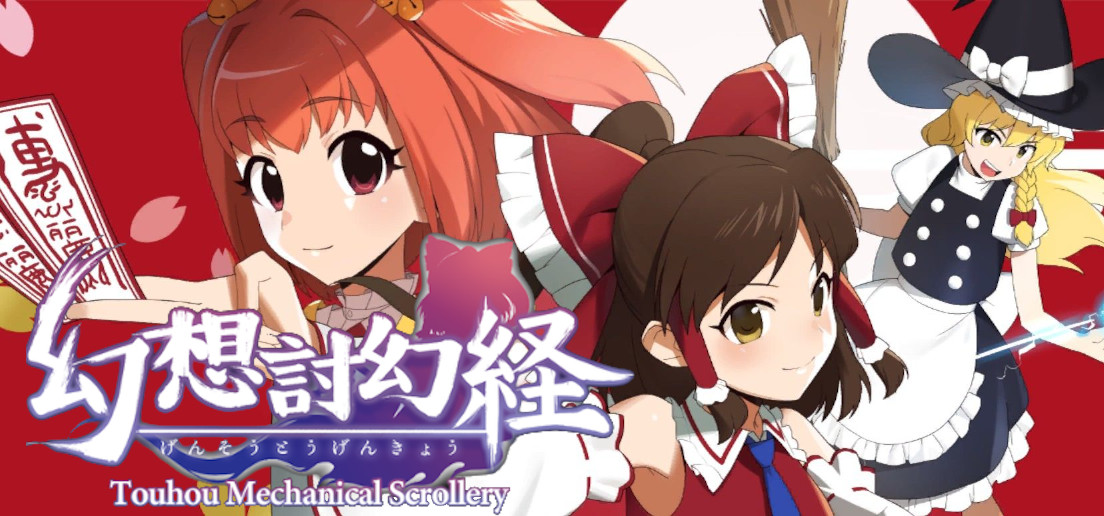3D Touhou: The dream of some, but a nightmare to control.
Type: Single-player
Genre: Action, Shooter,
Bullet Hell, Touhou
Developer: 巫女さん作法
(Miko-san Sahou)
Publisher: Phoenixx Inc.
Release date: 30 April, 2020


Intro
Way back when I was really active in the English-speaking Touhou community fanboards about a decade ago (yes, I am dating myself), one of the things that people would occasionally bring up would be how it would be “really cool” to have Touhou as a 3D shooter game instead of the classic 2D shooter the series had always been because it was an homage to those old-school 2D shooters. I remember arguing back that the basic Touhou formula just wouldn’t work in 3D because controls necessarily need to be looser in 3D than Touhou demands. The utterly ridiculous bullet clouds of Touhou would fill the screen with a solid glowing haze if you translated that to a first or over-the-shoulder third person perspective if you didn’t drastically reduce the number of bullets in the play space relative to the now three dimensions of volume you now have to fill. Like most Internet arguments, this tended to wind up with neither side convincing the other, however.
One of those types of people that always thought it would be cool to have a 3D Touhou finally went and did it, however, so it’s time to see whether I was right about what I was saying or if they finally showed me wrong.
… I don’t mean to say I told you so, but I told you so.
What Is Touhou? (Meta Version)
If you spend time socializing on the Internet, odds are good you’ve seen someone post a Touhou character in a meme, but just didn’t recognize the character.
The best analogy for Touhou is Harry Potter, specifically in that JK Rawling specifically helped foster the fan fiction community that up until then, publishers had actively tried to destroy, creating the space for all those Harry Potter fanfics that you love to cringe over.
Touhou (at least in its “main line” games) is a series of “doujin” (self-published) bullet hell (“danmaku”) games made by a single man, Jun’ya “ZUN” Oota. These games look like this when played at high difficulty/skill levels:
(Note the surprisingly good music for the guy who’s also the developer and surprisingly amateurish art style – there’s a reason official Touhou music gets remixed to death, but everyone makes their own Touhou art.)
The Touhou shooters would have been just an obscure hard-as-nails niche genre if not for the fact that ZUN went out of his way to declare he would not defend his copyright, allowing anyone to make any kind of fan work of his franchise they wanted, even if they charged money, without demanding any royalties in return. This is exactly the sort of “nightmare scenario” big publishers have always been “protecting” us from, and yet, it’s quite simply the best thing that could have happened to Touhou.
The reason is, a lot of people took the large cast of characters with ties to mythology but little characterization beyond that and could just put whatever story they wanted into these characters. This made it perfect for fanfic writers to tell the story they wanted even if it meant warping the canon character a little because hey, these characters needed a little flesh on the bones, anyway. Because many artists would flood Pixiv (the Japanese equivalent of DeviantArt) with art of these characters and fanfic writers would make much more content for these characters than even large franchises that would try to shut their projects down, many casual fans browsing the Internet would eventually just learn the whole cast of Touhou to read all this fiction and see what all the fuss was about. Because there was a massive built-in fanbase, any struggling starting author or artist that couldn’t attract any attention to their new works and original characters on their own could find easy, immediate viewers just by slapping a Touhou tag on their work, and if they had to just reskin the character they wanted to make into whatever was the closest Touhou character was to do it, then so be it. After they established themselves as a circle with a persistent following, they could try to strike out with original works that might get seriously published.
Two decades of games and still going strong later, some of the largest conventions for comics in Japan are Touhou-fanwork-exclusive conventions. Touhou is the KING of franchises in Japan specifically because it never signed on with a major publisher that would “protect” the franchise from all those meddling fans trying to make fanworks, and not doing anything to “protect the brand” made it into by far the largest brand any single person controlled. (It’s only with the advent of franchises that specifically copy the massive roster of historical characters and free fanwork model that some franchises like Kantai Collection and Fate have managed to actually unseat Touhou for the most fanworks in a year, but even now, their popularity wanes while Touhou springs eternal…)
The basic reason you, as a random Internet content devourer, might want to follow Touhou is because you will never, ever run dry for new content. It doesn’t matter what genre you’re looking for, from sappy romance stories (in whatever gender orientation you desire) to gruesome horror to intellectual mystery to HOT BLOODED FIGHTAN like Dragonball Z, there are literally thousands of fan comics you can read (mostly online for free) whenever you’re bored to dozens of fan-made games using the same universe. And hey, maybe you’ll find a content creator you’d like to follow even when they want to stretch out into creating original content, too…
What Is Touhou? (In-universe Version)
Touhou is centered on Gensoukyou (lit. “fantasy village”), a village in Japan that was sealed off from the rest of the (real-life modern) world using a magic barrier because all the gods, demons, and monsters were going to go extinct Puff the Magic Dragon-style due to the fading of belief in such things by humanity. As such, their plan was to create a sealed-off world where only the humans that still believed (usually because they had mixed god/demon/monster blood and therefore magic powers) would be let in and those people would keep believing in them while the rest of the world developed science and became a whole bunch of atheists that ain’t scared of no ghosts. (This happens a little after the time of Japan’s forced re-opening to the rest of the world, by the way, which is why everyone in the game still wears Taisho-era outfits. The English equivalent would be everyone wearing Victorian-era clothing… except the main character that goes around in a midriff-baring and scandalously armpit-revealing outfit.)
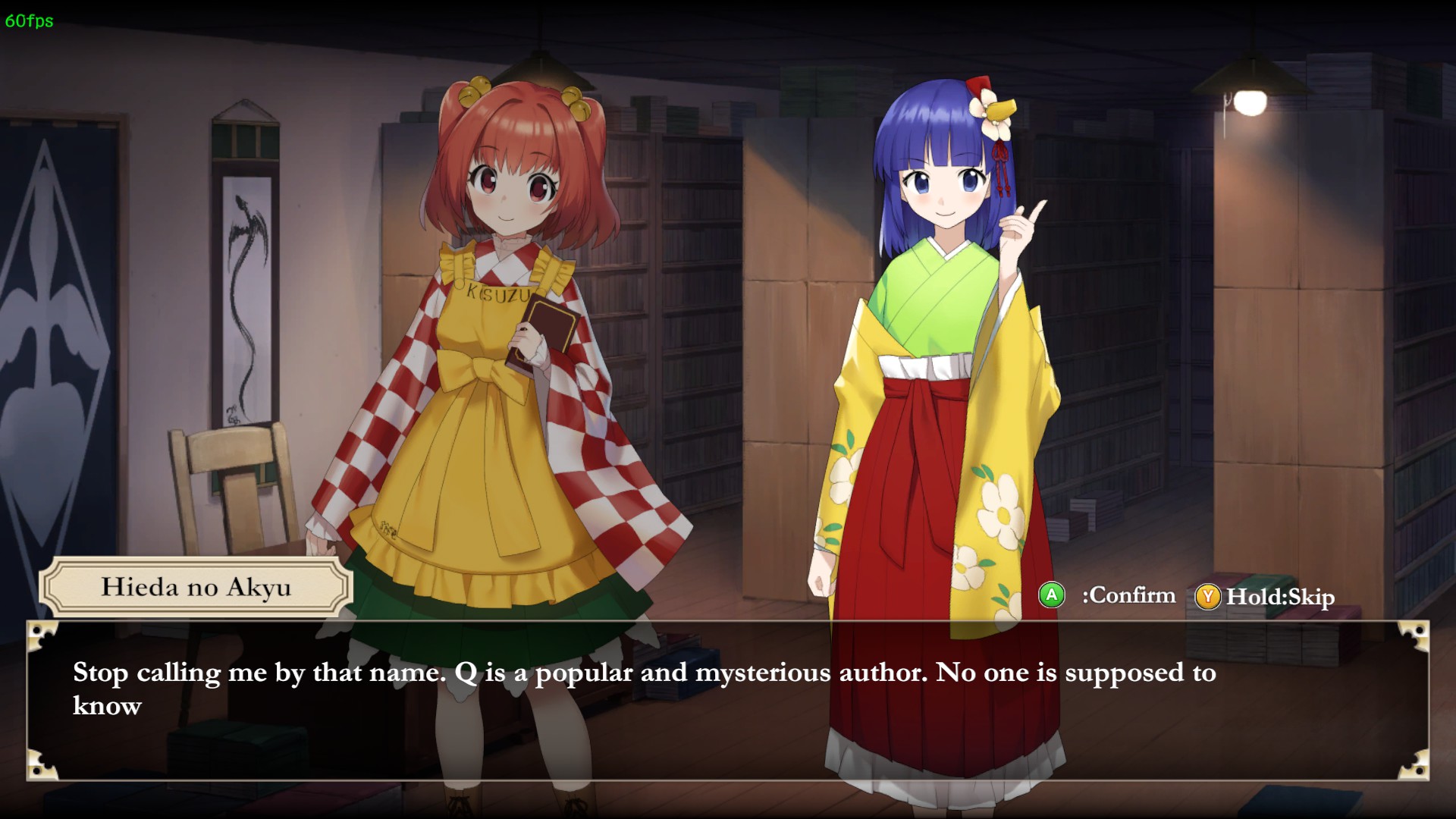
Gensoukyou, therefore, is made up of mythical creatures and also is designed to take in all the things that “have transcended into myth” from the real world to preserve them within. This last bit is generally the impetus for most of the games: Some new people or thing that has transcended into myth enters Gensokyou, causes a ruckus, and Reimu or Marisa have to resolve things. This can be anything from legendary former emperors of Japan reincarnating (as little girls, of course) to forgotten gods moving their last worshipers/descendants into Gensoukyou and having a turf war with the existing shrines to Gensoukyou suddenly having cold fusion power because people realized it was “mythical” in the real world.
The main thing supporting Gensoukyou’s existence is the Great Hakurei Barrier, which separates the magic from the mundane. It’s heavily supported by some of the gods and monsters, but its cosmic keystone is the bloodline of the (humans with magic powers) Hakurei shrine maidens. The main character of the series just happens to be the latest generation of the Hakurei line, Reimu Hakurei. When something causes trouble, everyone shoves it off onto either Reimu or her best friend and former rival Marisa.
Because they’re putting the one being that cannot be allowed to die (at least until she has an heir) in harm’s way fighting gods, demons, and monsters vastly more powerful than her, the powers that be also created the “spellcard system”, which basically is the excuse for this to be a shooting game. You’re not allowed to just club everyone to death with Herculean strength, you need to turn all your powers into glowy bullets the other side has to dodge, and your special moves are now “spellcards” (the equivalents of “bombs” in other shooters) that temporarily give you invincibility and let you shoot FREAK TONS of bullets at a time.
Oh, right, and while the side books will have mention of male characters, every character that actually fights in Touhou is a girl. In-universe, the reason is that because it’s nonlethal glowy bullet playtime, it’s considered “girl stuff” to shoot people you just met with giant lasers like it’s the regional version of saying “hello”.
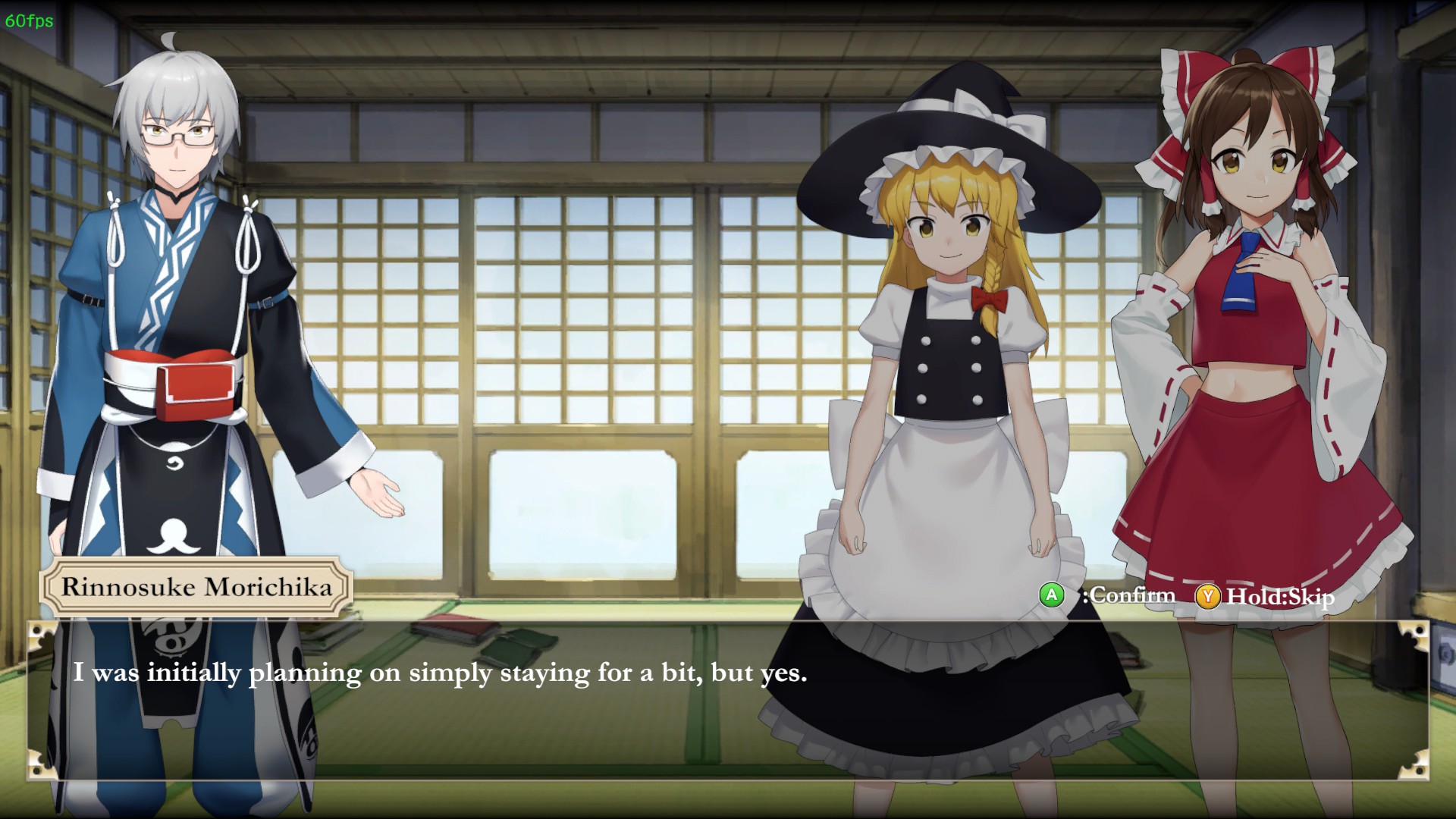
What Do You Mean, “Doujin”?
So, I wrote up all this background to tell you what Touhou is, and also to tell you that this isn’t the “real Touhou”. It’s a fan-made game. In fact, punching “Touhou” into a Steam search results in 230 games popping up as of this writing with games popping up in 2017, but it was only in late 2019 that the back catalogue of “real” ZUN-made Touhou games started popping up on the Steam storepage. (But hey, they’re here now, although you need to use an unofficial English patch.)
This isn’t to say there’s anything wrong with a doujin game, of course, part of Touhou’s whole appeal is that everyone can try their own take on it, but that the mood, themes, genres, and quality of any given work tends to differ wildly depending upon who’s making the doujin.
3D Touhou Controls
So here we come to the first, and largest hurdle in the actual game I’m reviewing…
The actual controls are rebindable from the start menu, however, if you have a controller (or something that the game detects as a controller), then keyboard controls are disabled except using arrow keys and enter on the menu. Note that it presumes an XBox 360 controller, and while you can rebind what the A and B buttons do, A and B are confirm and cancel regardless. Because I find the Steam controller’s face buttons require enough force to press that it hurts my thumb to use those buttons too often, I recommend making the grip buttons your A and B buttons, as well as making the nice, soft trigger buttons the attack buttons you’ll spam.
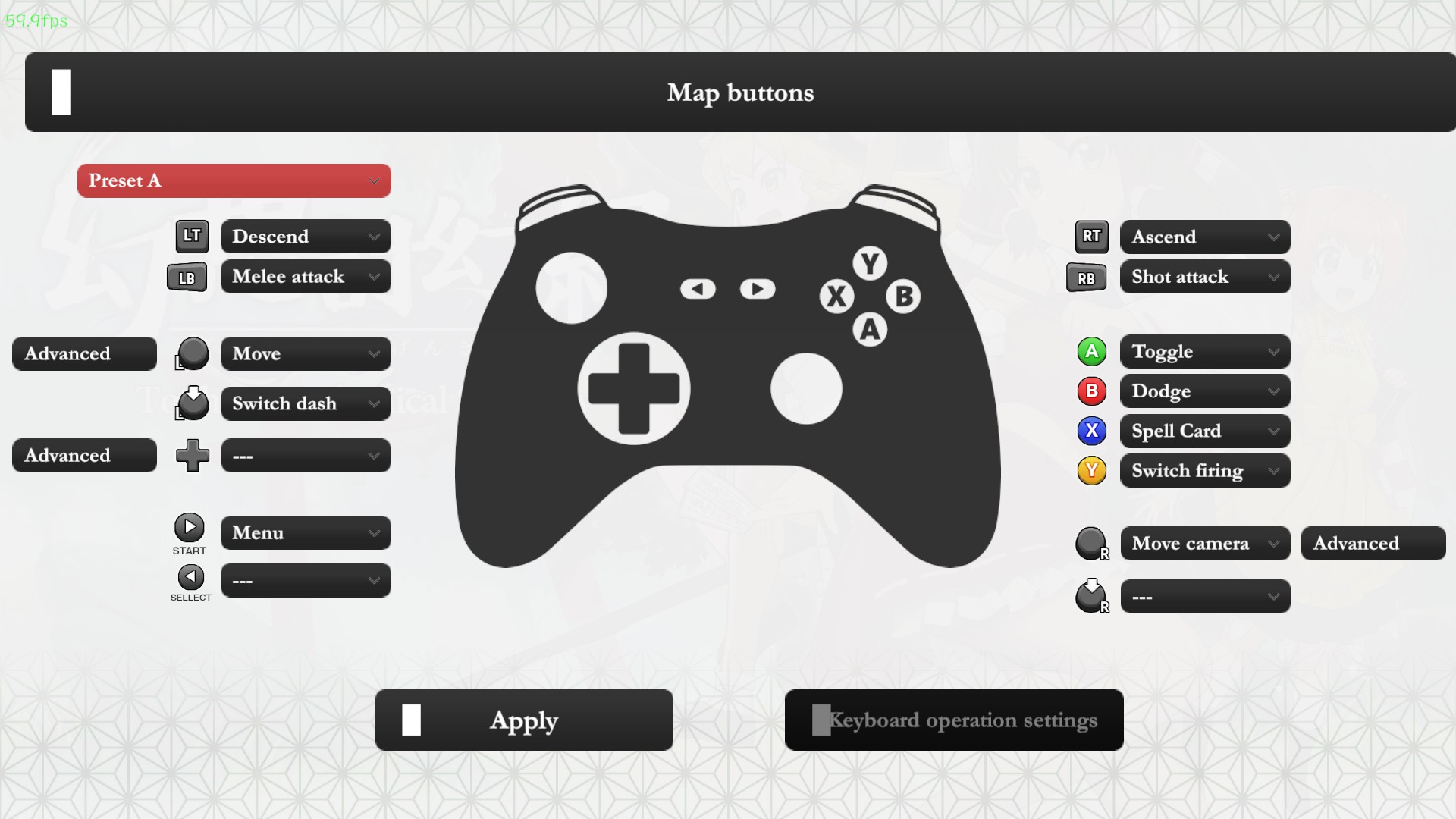
If you don’t have a controller or can be bothered to unplug everything to satisfy this one game, the game can run with the mouse controlling the camera and left/right click being your attacks, while there is also a keyboard-only option. I cannot testify to how well those actually work, however.
Something to note is that the game supposedly has a menu that you can open by pressing the start/> key, as well as healing items you can presumably use from the menu. This menu never worked for me, nor does pressing escape. Who needs healing items in a Touhou game, anyway, I guess?
This, however, gets me to the movement…
If you’ve played a Touhou game or watched that (second) video with the Touhou gameplay, you’ll notice that the game revolves around at times literally pixel-perfect movement. Touhou controls are very simple (four movement directions, a “focus” button to make you move slower/more precisely, a shoot button you might as well glue down, and a spellcard/bomb button to clear bullets when you’re cornered), yet the game demands absolute mastery over this simple control scheme. You generally don’t think about shooting in a Touhou game, it’s all about the dodging, and if you can shoot the boss while doing it, that’s a nice bonus.
Mechanical Scrollery, however, has extremely floaty movement controls. Your character glides off with momentum against your will. If you’re facing to the left and press right on the stick, the character will start flying to the left for a solid second or so before maybe making up their mind which way they want to turn to start flying to the right, instead. Your controls are wildly imprecise. I cannot stress enough how utterly anathema to the concept of Touhou movement controls this absurdly difficult to control are. The control you have over your character is so awful that this factor alone would have made me quit playing it were I not obligated to complete a review of it.
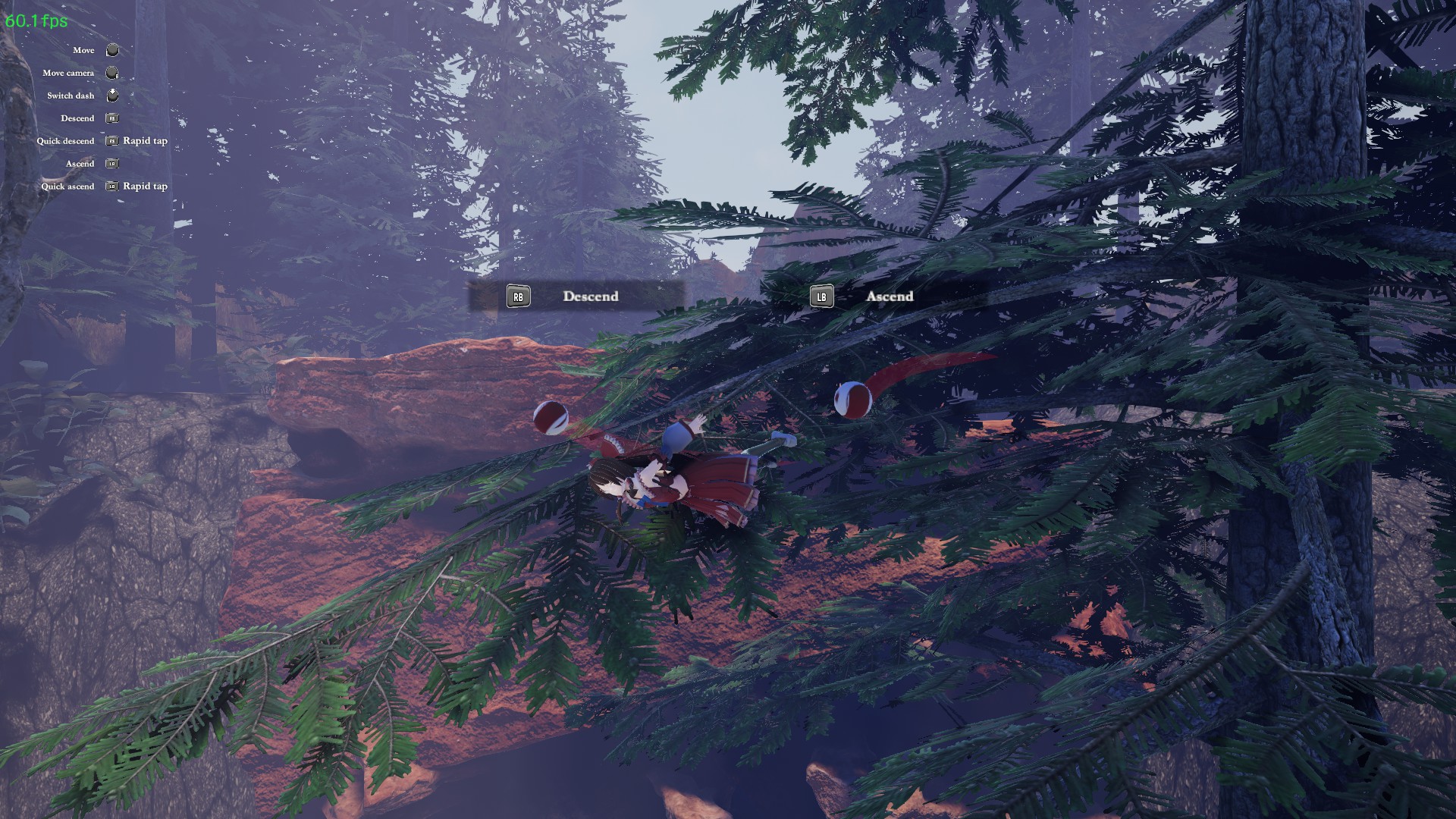
There are six buttons to move in three dimensions, which is fine enough, although the up/down controls are slower unless you double-tap them to dodge/dash up or down, which doesn’t work for horizontal movement. Instead, you have a dedicated “dodge” button for horizontal dodging which incidentally also makes you invincible and lets you charge up your ranged ammo if you run through bullets, which this game calls “grazing” unlike the “real” Touhou games where “graze” gives you points (and depending on the game, fills a “tension meter”) based upon near-misses, encouraging flying dangerously close to bullets for score.
There are two separate “switch movement mode” buttons, one of which makes you faster but doesn’t let you stop until you toggle it again, while the other is “sniper mode” and changes your shot type while making you much slower and more difficult to control.
There’s also a “target lock” button that, when held down, toggles whether the camera is focused upon a single target, hypothetically preventing the need to manually control the camera (and taking manual camera control away) and letting you do a home-in melee attack dash. This is an absolutely terrible idea, and I cannot recommend anyone who gets motion sick from playing games never, ever, EVER use this function enough. The function is scientifically calibrated to pick the target you want to focus upon least. If your reticle is on an enemy, it will pick an enemy on the right edge of the screen and focus you in on it, because screw you. It will also automatically switch targets the instant your target dies, so if you were launching a melee attack against the enemy right before it blew up and there is another enemy right behind you, it will automatically target another enemy three zip codes away and have you do the “melee dash” straight into a wall you get stuck into and have to spend four or five seconds having to find a way to steer your character away from because, again, it’s a struggle to steer in this game. Using lock-on is terrible in ranged combat because your shots will always miss a moving target. Using lock-on is terrible in melee combat because you’ll do the godawful melee dash that often misses and sends you flying past your enemy while the camera shakes at epilepsy-inducing speeds to try to keep your character and the enemy – both jumping past one another – in frame.
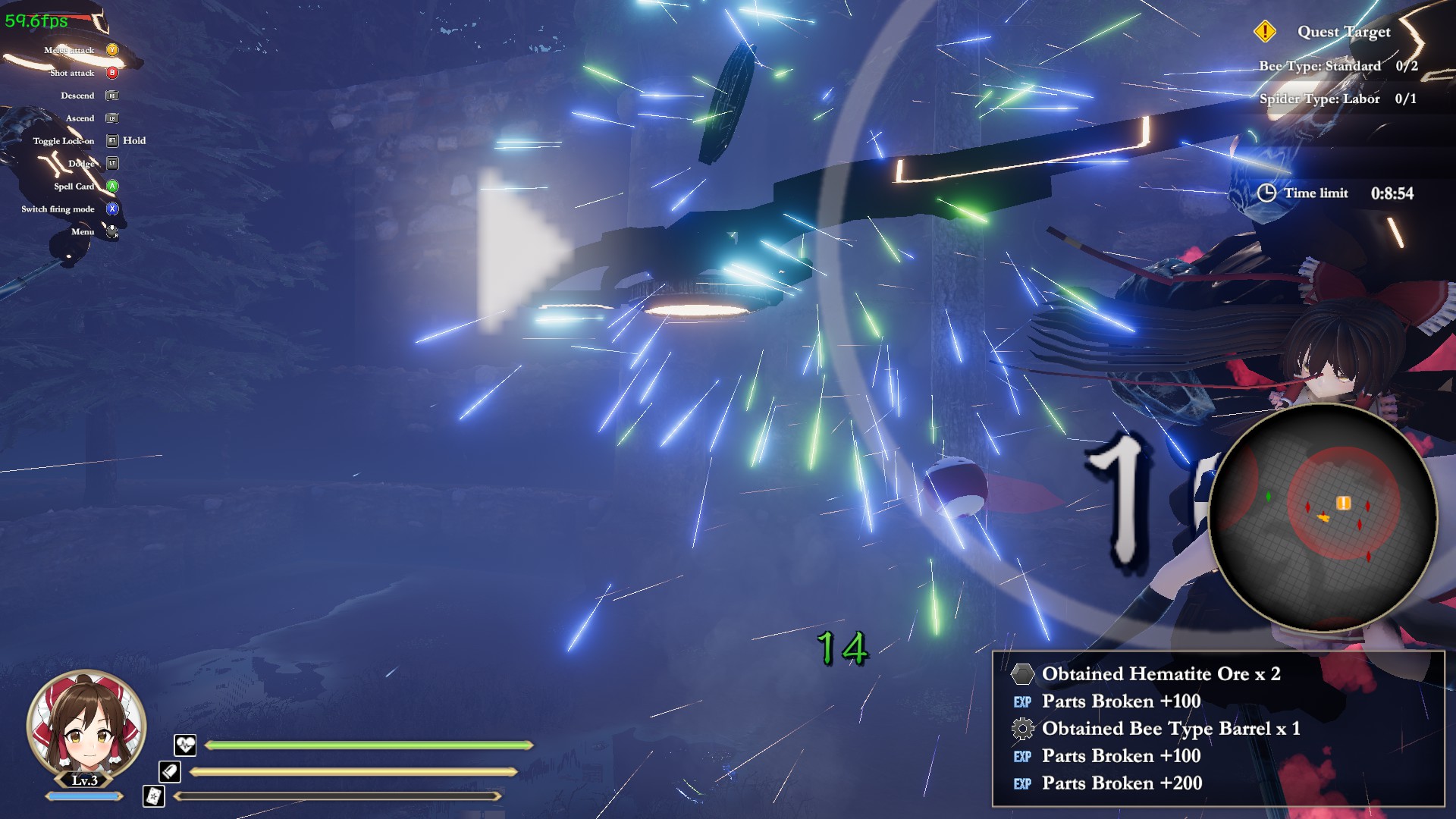
Using lock-on is terrible.
Melee the Bullet
However, that’s still burying the lead. I already said that nothing was more anathema to the concept of “a Touhou game, but now it’s in 3D” than having incredibly unwieldy controls, but second prize goes to not letting you fight at range. Yes, I was talking about melee attacks in the game whose concept is that nobody is allowed to use melee.
See, one of the basic, fundamental problems with third person shooting is the the problem of depth perception. A 2D Touhou game leaves absolutely no doubt how far away a bullet is from your character because you have a third person overhead viewpoint where distance is measured in number of pixels between bullet and character. Even in a typical 3D game with lots of enemies, you can generally create a frame of reference for how far away an enemy is by understanding its size. A Dynasty Warriors game features almost exclusively human characters, so if you see some small human figures and some large human figures on the screen, you can pretty quickly tell the small ones are probably further away because the character models are all generally the same size.
This game, however, has glowy balls everywhere. These are differently-sized and differently-shaped glowy balls at that, so you can’t even use relative glowy ball size for reference. Even if you understand what a purple-colored bullet is shaped like, you’ll suddenly be surprised by the plum-colored bullet which is slightly smaller and more blue, so it is actually closer than it appears. If there are more than one glowy ball overlapping in your view, they bleed together into a single mass of indecipherable glow.
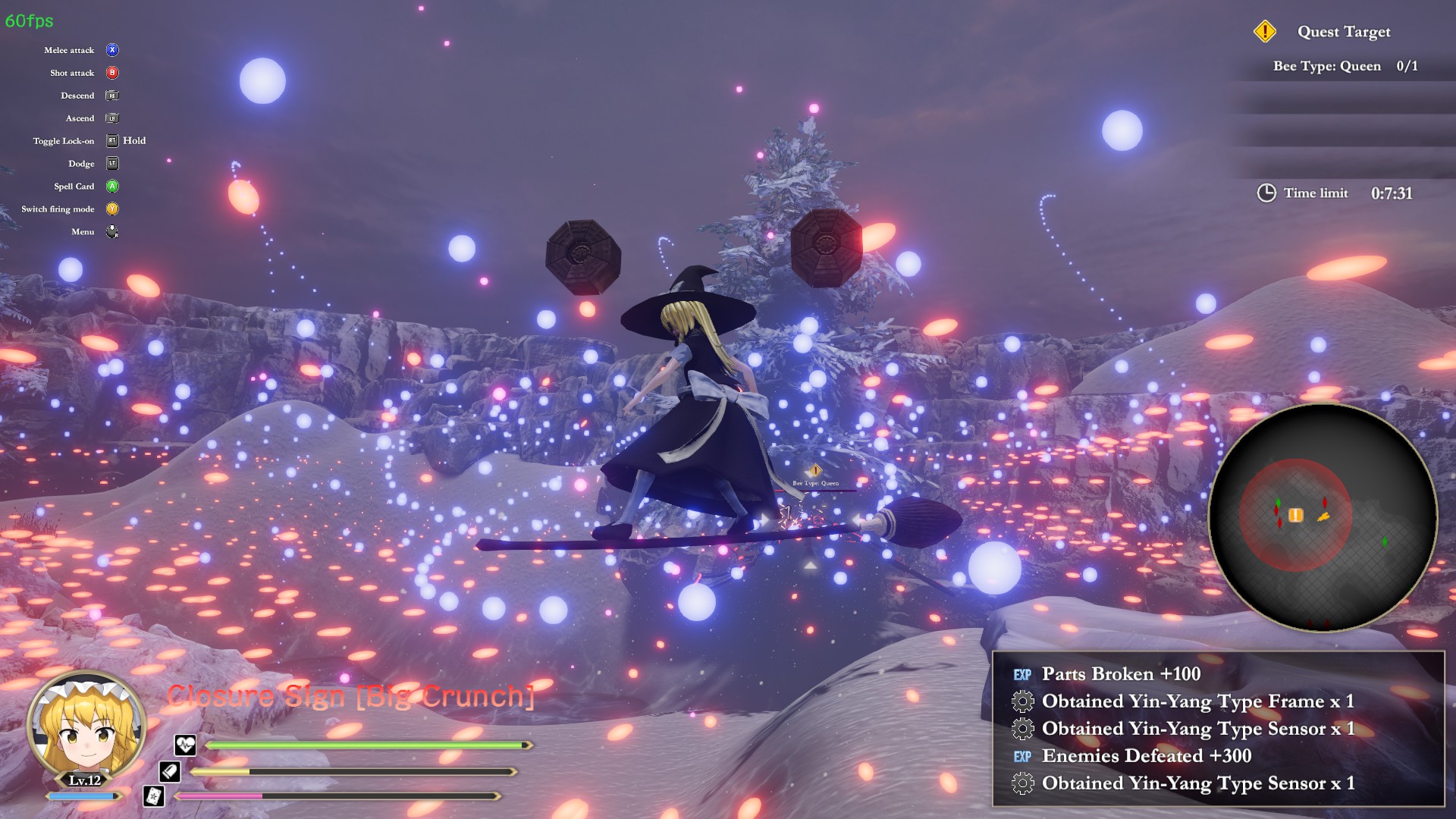
One thing I haven’t mentioned yet is that in the “real” Touhou games, your bullets are transparent specifically so you don’t screw up your view with your own shots. In the image above, my own bullets from my spellcard are the exact same kind of blue glowy balls as the enemy shots can be. It’s almost impossible to distinguish your own supermove’s bullets from the enemy’s! In fact, when you break off an enemy part and get a material, it creates a glowy green ball that homes in on your character that looks an awful lot like a bullet.
All of this isn’t to say that it’s hard to avoid bullets, however. It’s ludicrously easy to avoid any bullet you can see. (Although the enemies can certainly fire bullets from behind you where they aren’t on camera, which is another reason why 3D shooting games tend to suck.) The problem is you want to hit the enemy bullets.
Yes, that’s right, this game’s shooting is so messed up that I want to get shot (because dodging through bullets gives me more ammo), and I find myself nearly incapable of impaling myself on the enemy’s bullets when I try to on purpose! You can often tell that a bullet is above or below you, but how much is a massive mystery because of how incredibly difficult it is to distinguish distance on a glow ball. (It’s almost as if the game would be made better by making the bullets be something you can see clearly and reference against each other to judge distance rather than just mindlessly putting in the same glowy bullets from 2D Touhou because it’s iconic…)
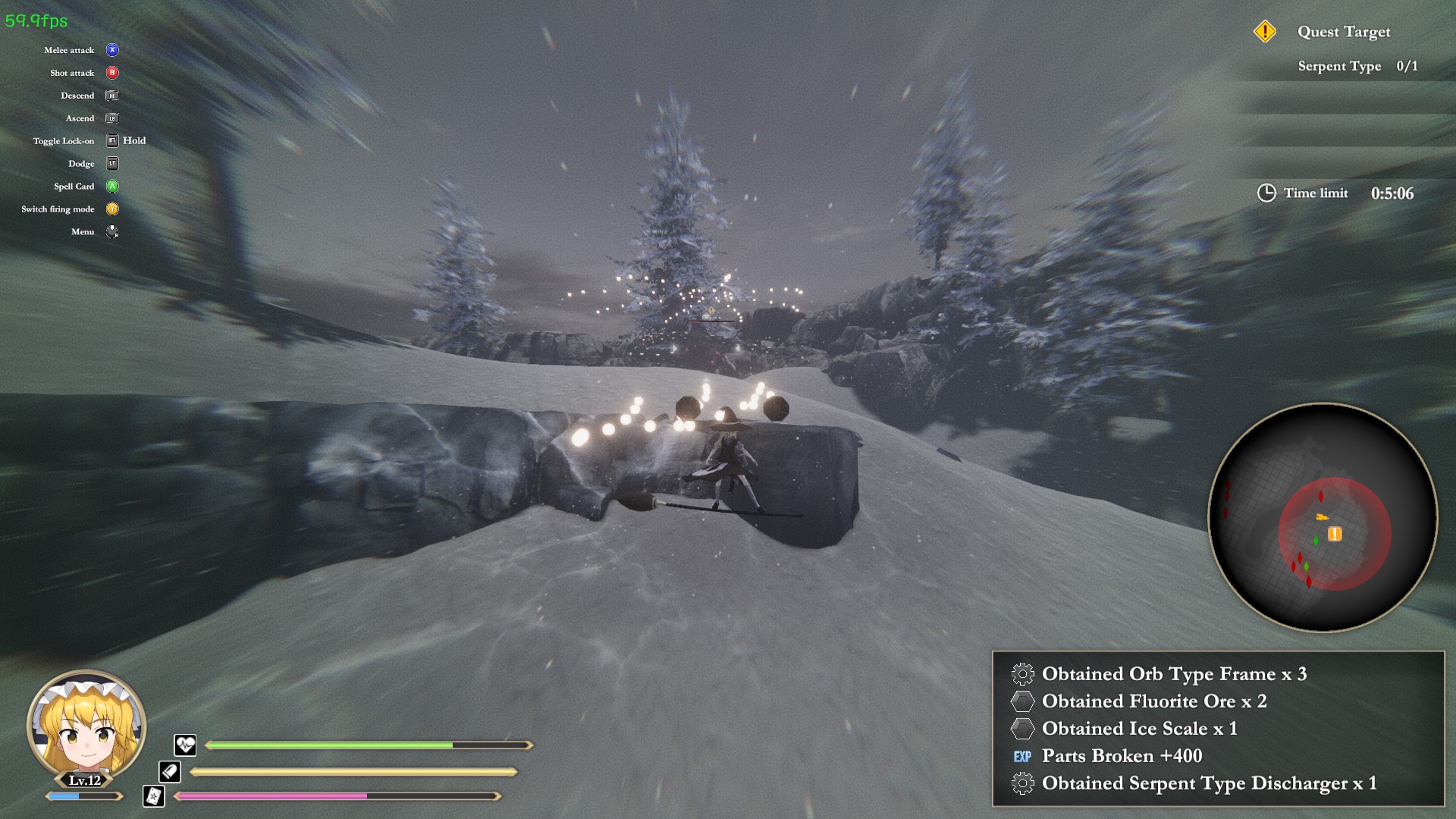
This is basically the result of the fundamental problem with 3D shooting games I mentioned way back at the intro – there’s no way to create the kind of bullet density a 2D Touhou game has without making the screen a single blinding white sphere of bullets whenever the enemy fires, but if you have lesser numbers of bullets being fired,
This is important because you have limited ammo (in a TOUHOU GAME) to prevent you from just shooting the boss monster from long distance where everything is easily evaded. There are two ways to get more ammo – either you melee attack enemies, or you “graze” bullets.
In the case of some boss monsters, like the one in the image above, the bullets actually home in on you (importantly, including vertically, which most shot patterns do not), making it easy to deliberately target the bullets and “dodge” into them to refill your shot meter and keep up an attack on them.
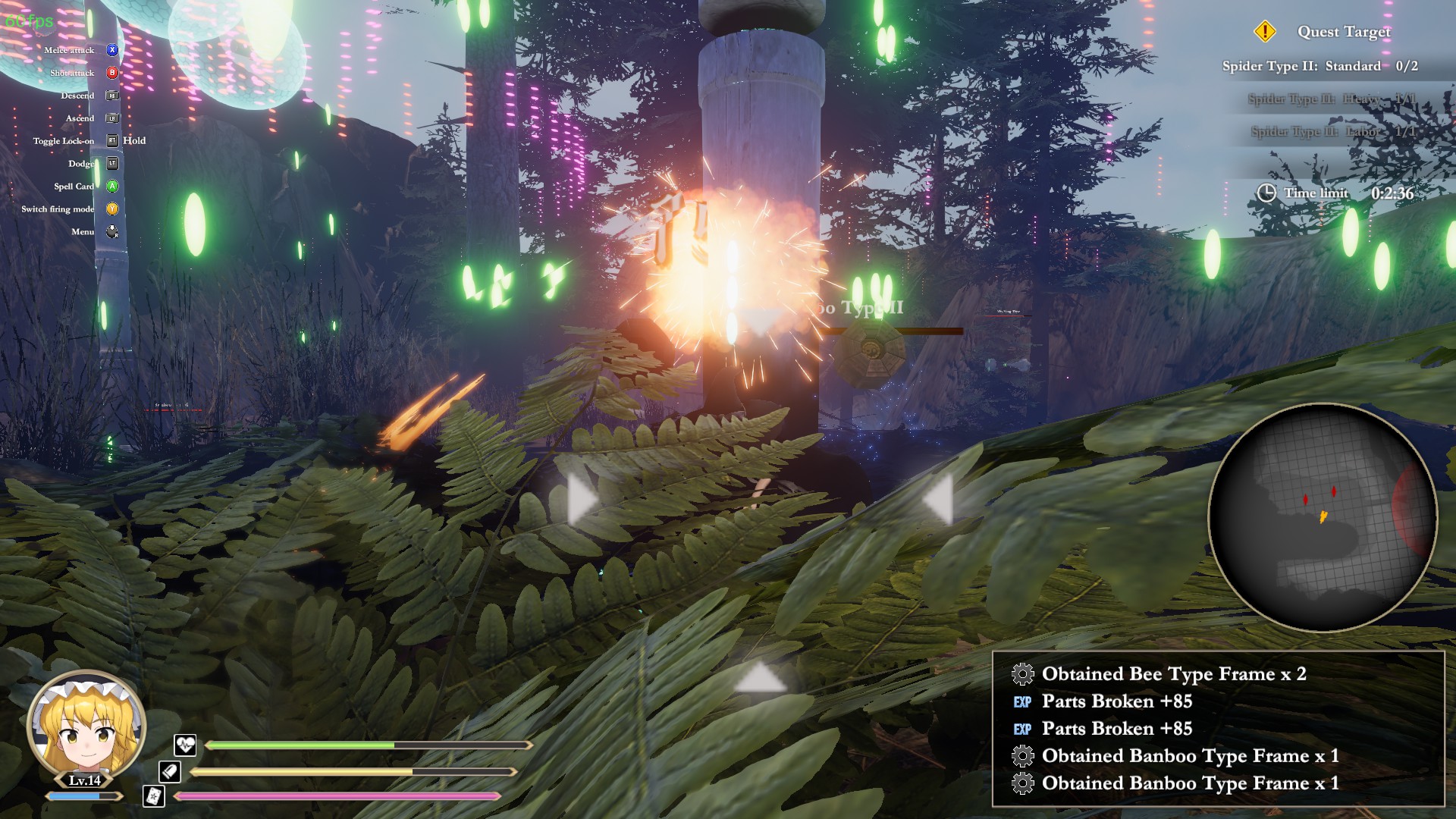
Against all other bosses, however, melee is suicide because, while enemies have some wind-up, your melee attack animations are three times longer than the enemy’s tell and also randomly move your character around against your control (often missing because of it), so you’ll die in seconds if you try to melee a boss.
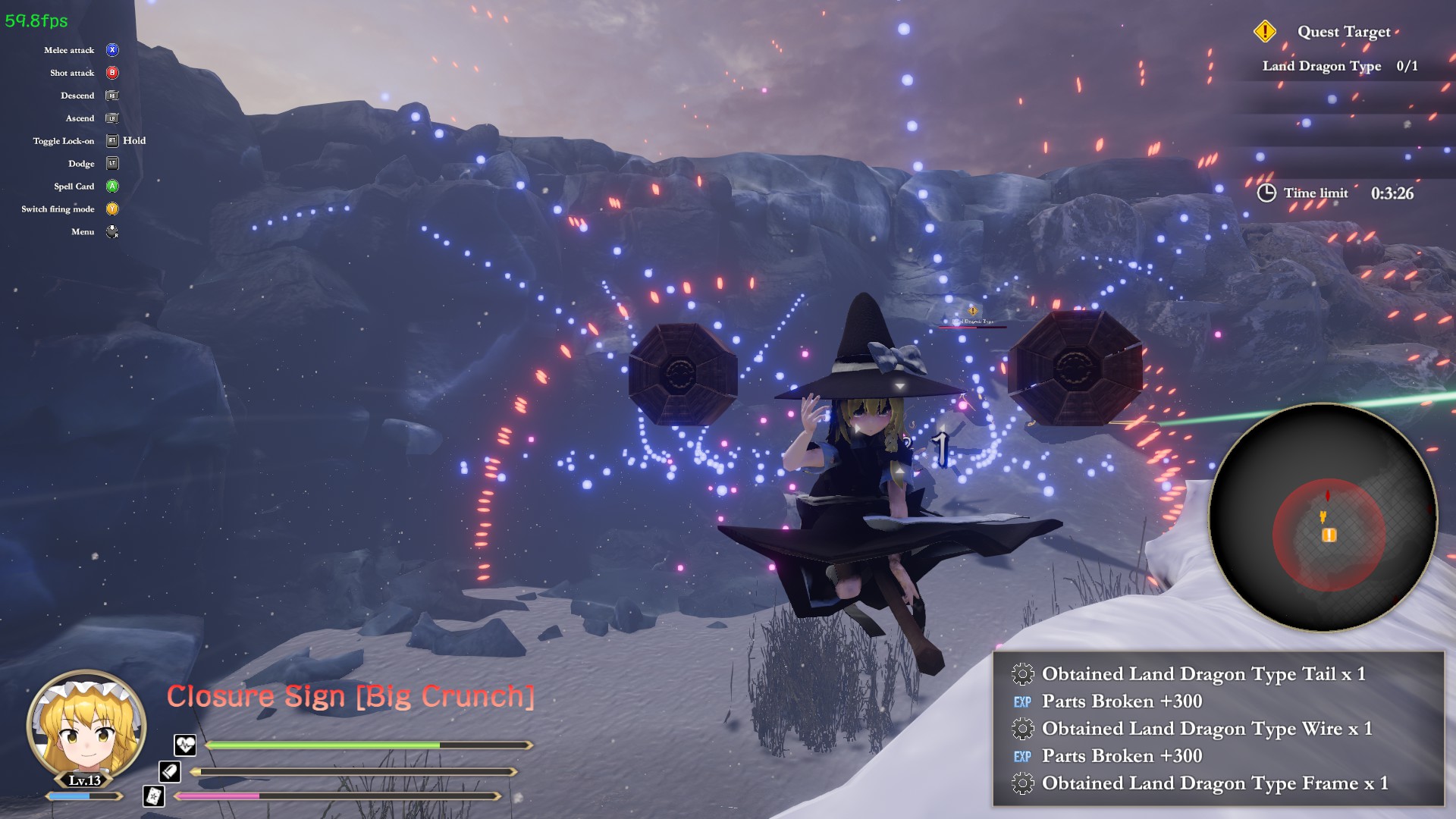
This leaves you with no other option but the utterly boring one – you fire all your bullets at the boss, retreat, find some low-level mob to gank with melee to recharge your bullets, then come back and fire off your bullets from range again.
If there’s one thing that shouldn’t describe boss fights, it’s “boring”.
Part Grinding and Equipment
What can I say, but that clearly, whoever made this game wasn’t inspired just to make Touhou, but 3D, but had clearly also been playing a lot of Monster Hunter right before making this game…
So, every enemy has multiple “parts” that you can shoot individually to snap off and give you materials.
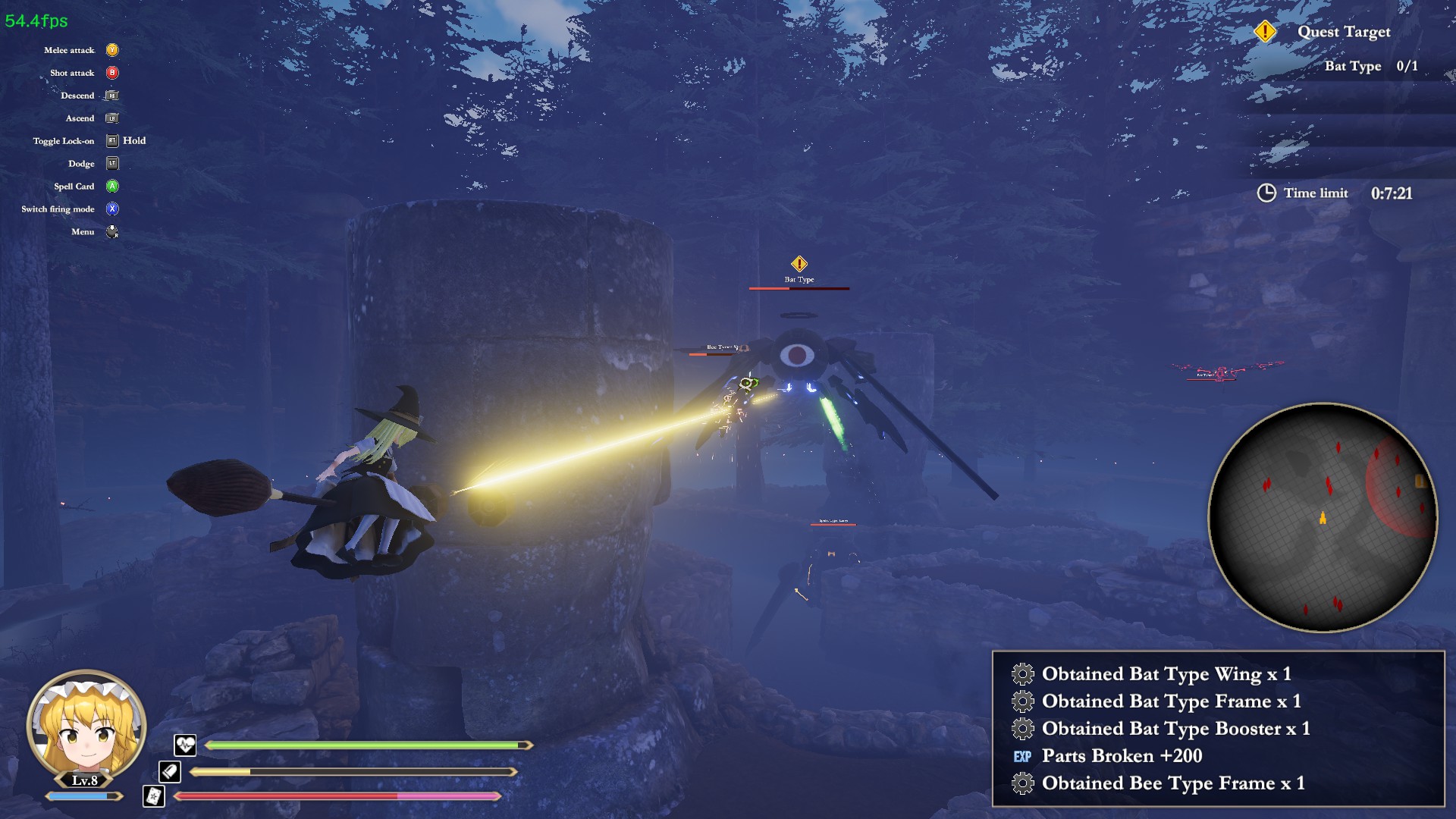
Once you have done this, you can either sell those parts for cash or you can use them to upgrade your equipment which has various kinds of special abilities…
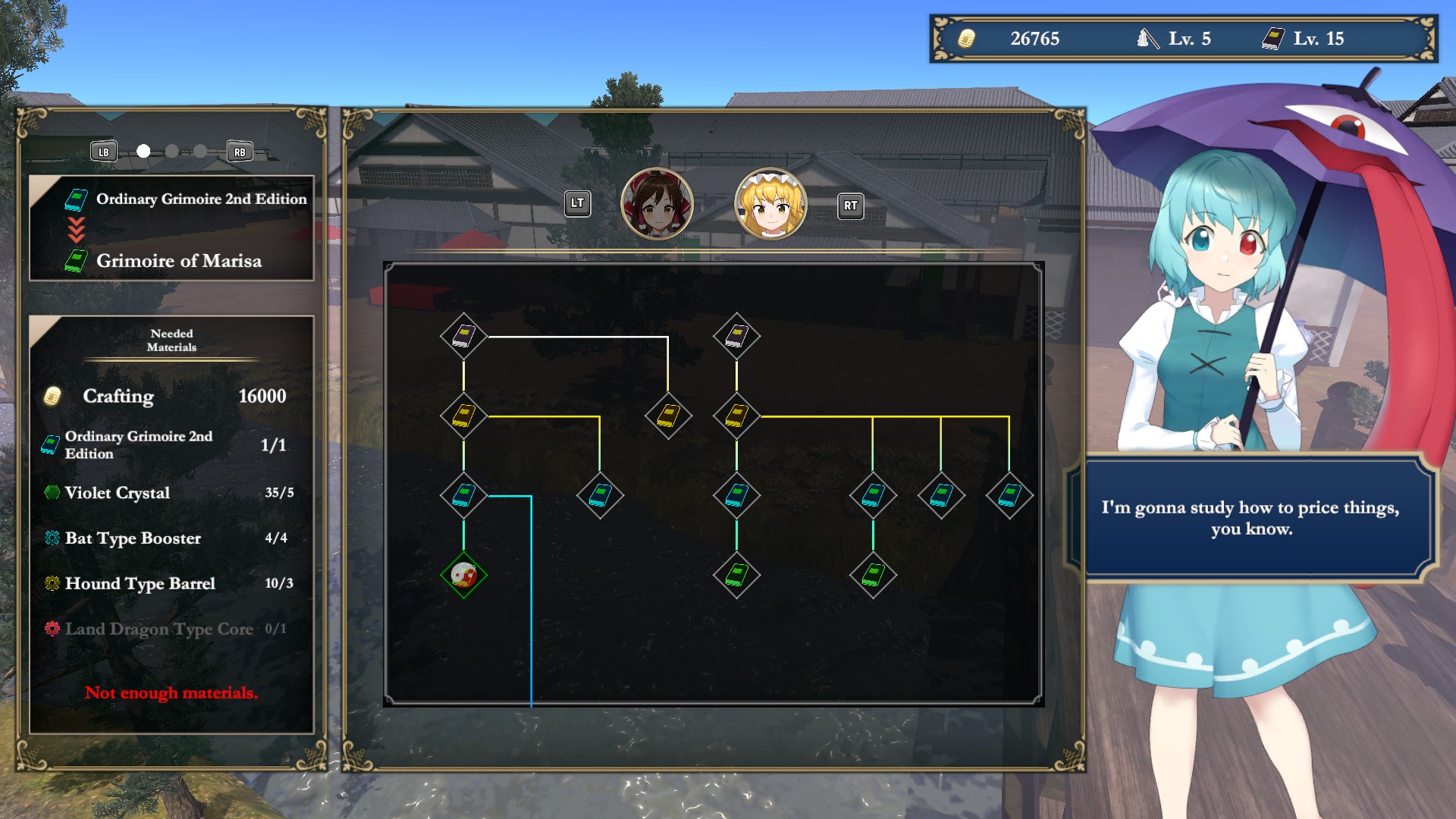
Since some of these special abilities include the likes of “your ammo guage goes down less while shooting”, some of these are absolutely vital for making the game even more miserable than it already is.
Twelfth Verse, Same as the First!
Another major letdown in the game is how missions are set up. Every “chapter” in the story is a single book you need to “explore”, but every stage is the exact same map. I mean, the exact same map with the same resource points and even the same enemies (although boss monsters only appear in their own particular stage).
I try to be lenient on such obviously low-budget developers, but I’d honestly rather have sloppy maps than have a tiny number of maps that have… well still not that much detail put into them.
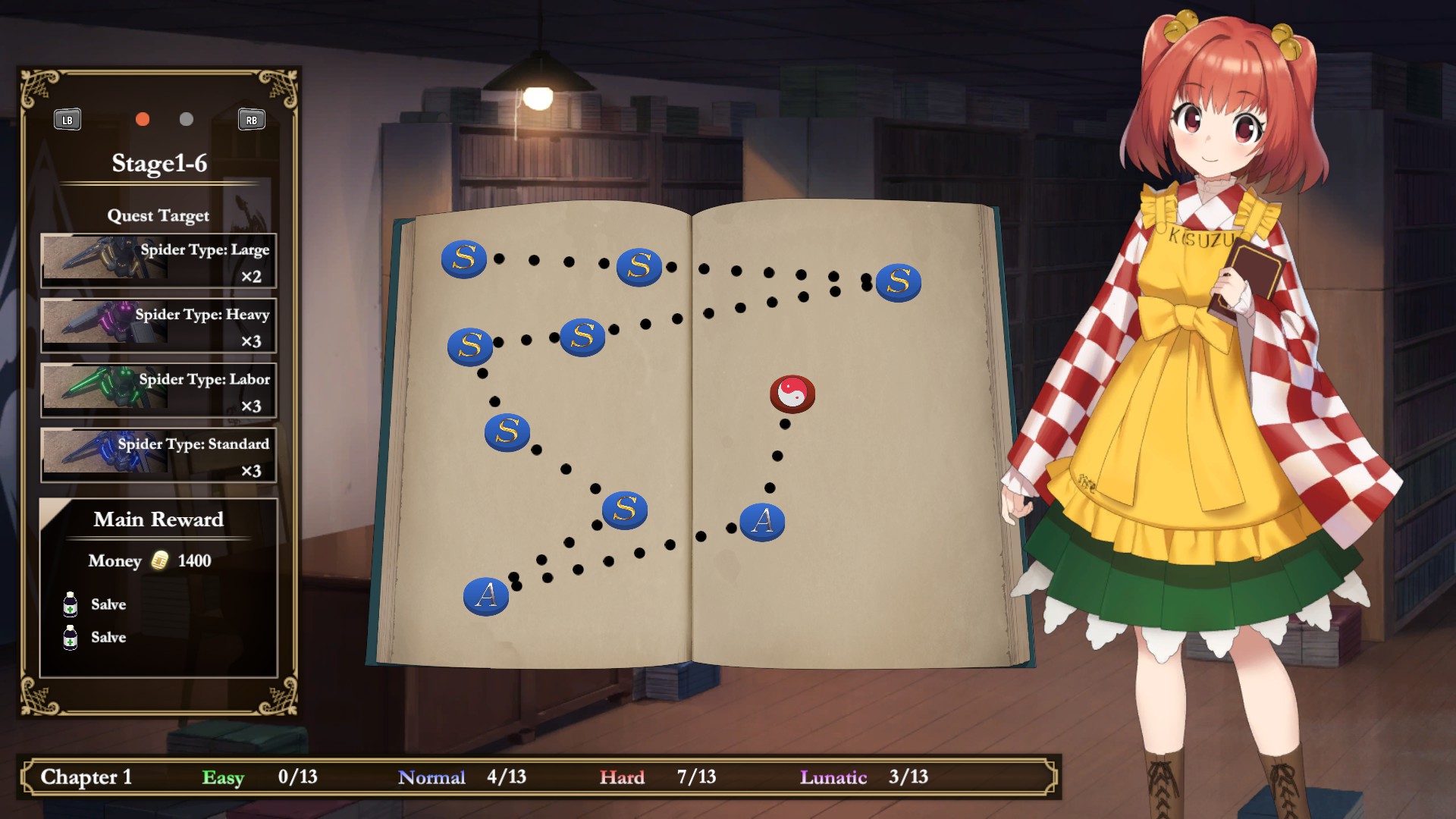
It goes like this: You start chapter one in front of two “normal-type” spiders with a handful of other enemies scattered in about six different clumps. Your first mission is to kill two normal-type spiders. Your second mission is to kill a couple bees that appear near the back. The eighth mission is killing both the bees AND the spiders. There’s a dozen missions that are all the same map, but where the clear condition is killing different combinations of the same monsters. You can piss around shooting whatever, but there’s a time limit and the mission stops 15 seconds after you kill your mission objectives, so it pays to pick something that you aren’t trying to farm for parts so that the mission doesn’t stop when you kill half of them.
Additionally, there’s a ranking system. I’m not sure why, because you don’t get anything but an “S” and some random drops you could get from the mission itself for doing it, but the main thing is you need to kill lots of enemies in excess of what you needed to complete the mission (which means postponing the mission objective enemies as long as possible) to get it.
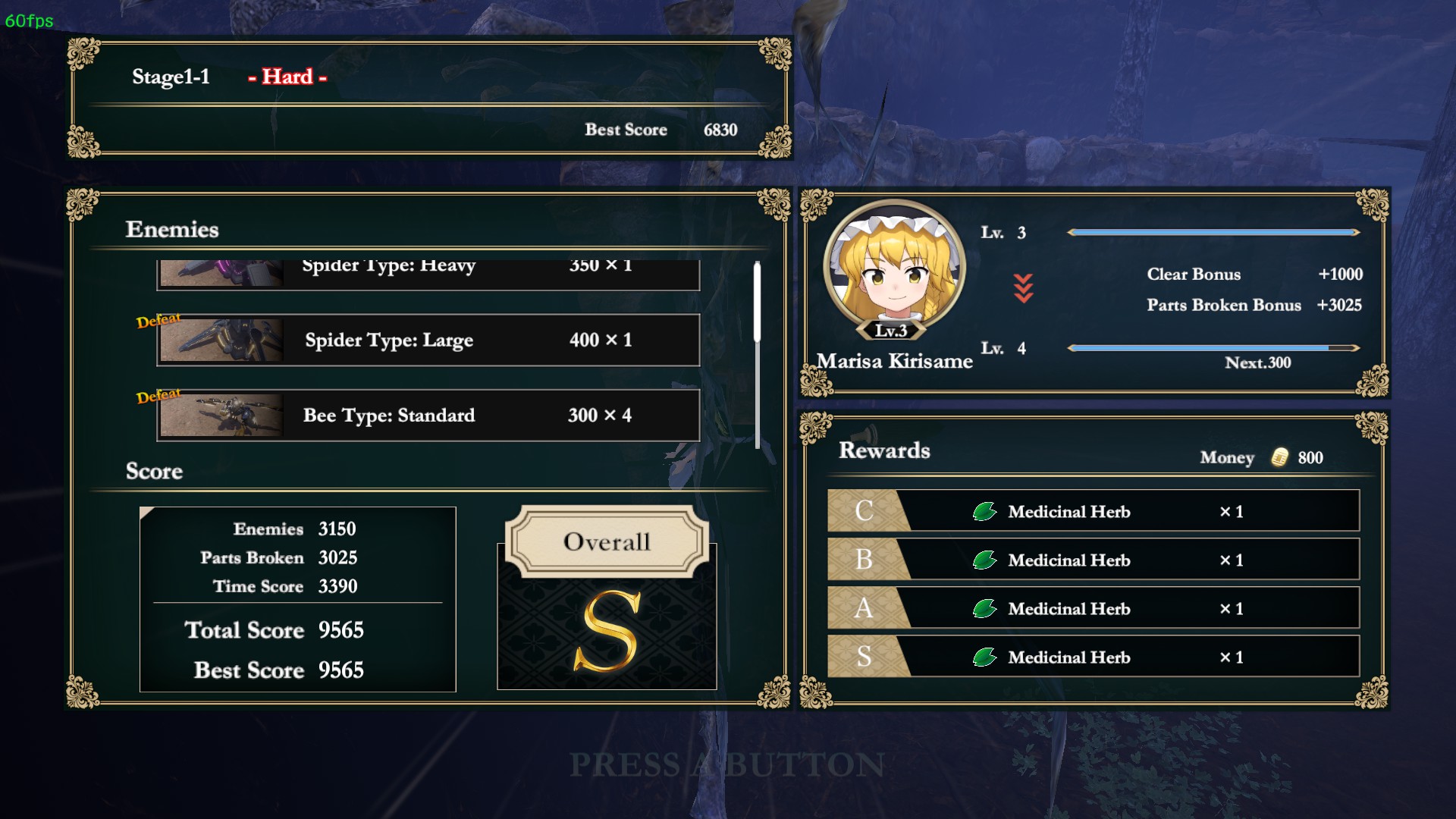
Music
Because ZUN is a good composer of catchy chiptunes and there’s a whole cottage industry of remixing his melodies into songs with full-on vocals and everything, there’s never a dearth of good Touhou music. I can’t say who actually composed the music I hear in this game, but it’s almost certainly not the developer. It’s just a benefit of the lack of copyrighting that the developer can pick and choose whatever remixed version of the series’s signature music they want into a game no matter their own talent with music.
Graphics
Like I said with the music, it’s very probable that very little of the game’s graphics were actually made by the developer. There have notably been a wide array of cell-shaded 3D models of Touhou characters to go around for modding all sorts of games (including a Grand Theft Touhou mod or Elder Touhous), and I can’t help but notice how much of a contrast the art styles are between the cell-shaded characters that obviously are trying to be cartoony and the landscapes that are obviously trying to be realistic.
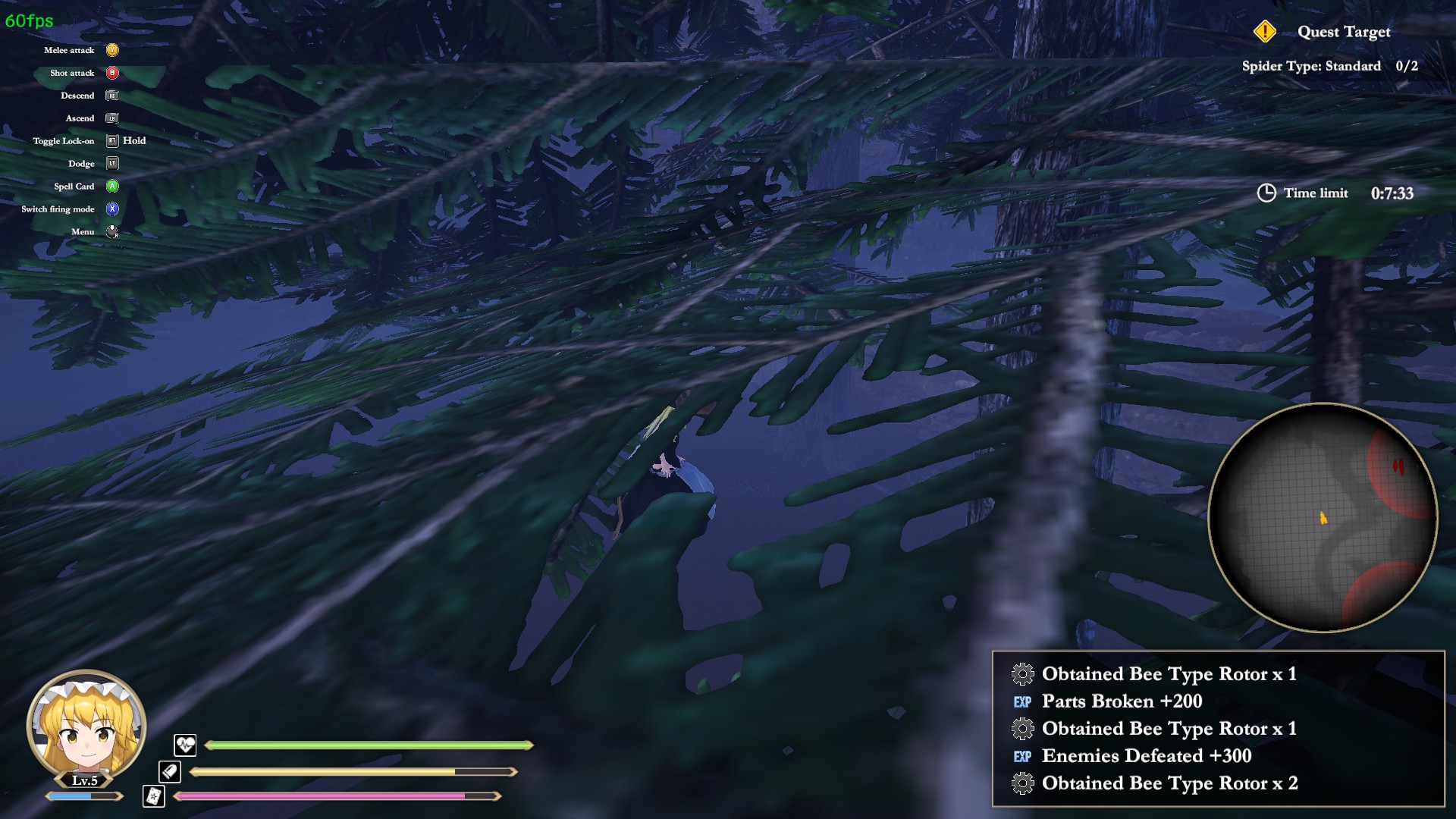
Again, I don’t want to be too hard on a budget developer for not making AAA graphics on their own, but I can’t help but feel that the game would have been better served trying to find assets that actually fit the cartoony cell-shaded characters and glowy bullets rather than this desaturated snowy field with realistic-looking pine trees stuff we get.
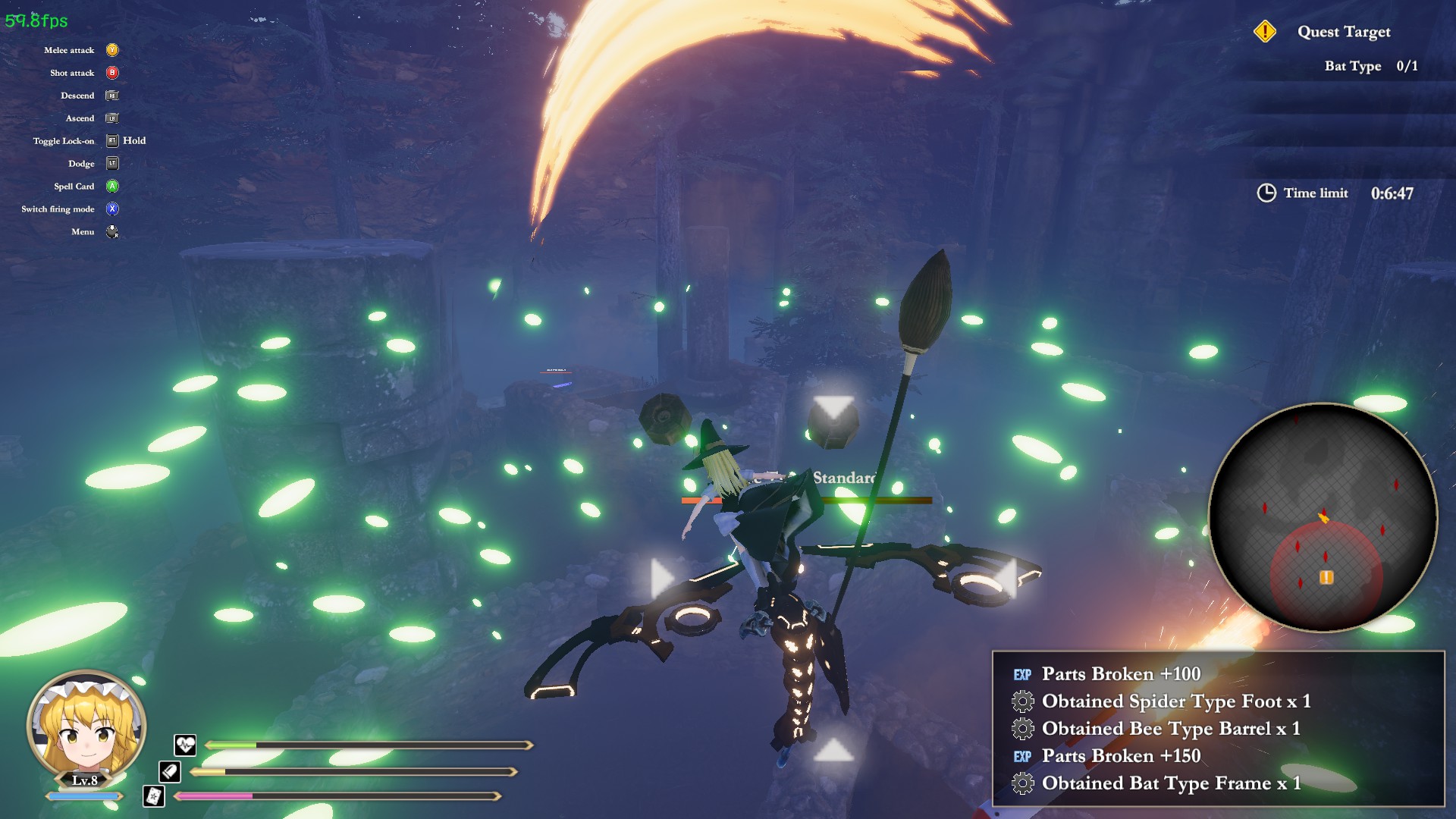
There’s also a pretty serious disconnect between what a character is animated as doing and where it’s actually attacking. Dark Souls this isn’t. You basically cannot gauge what an enemy is about to do or is doing based upon its posing because it contorts so wildly. Generally, this is a good reason to stay at range, but again, the game is so easy at range that the game has to connive ways to force you not to stay at range.
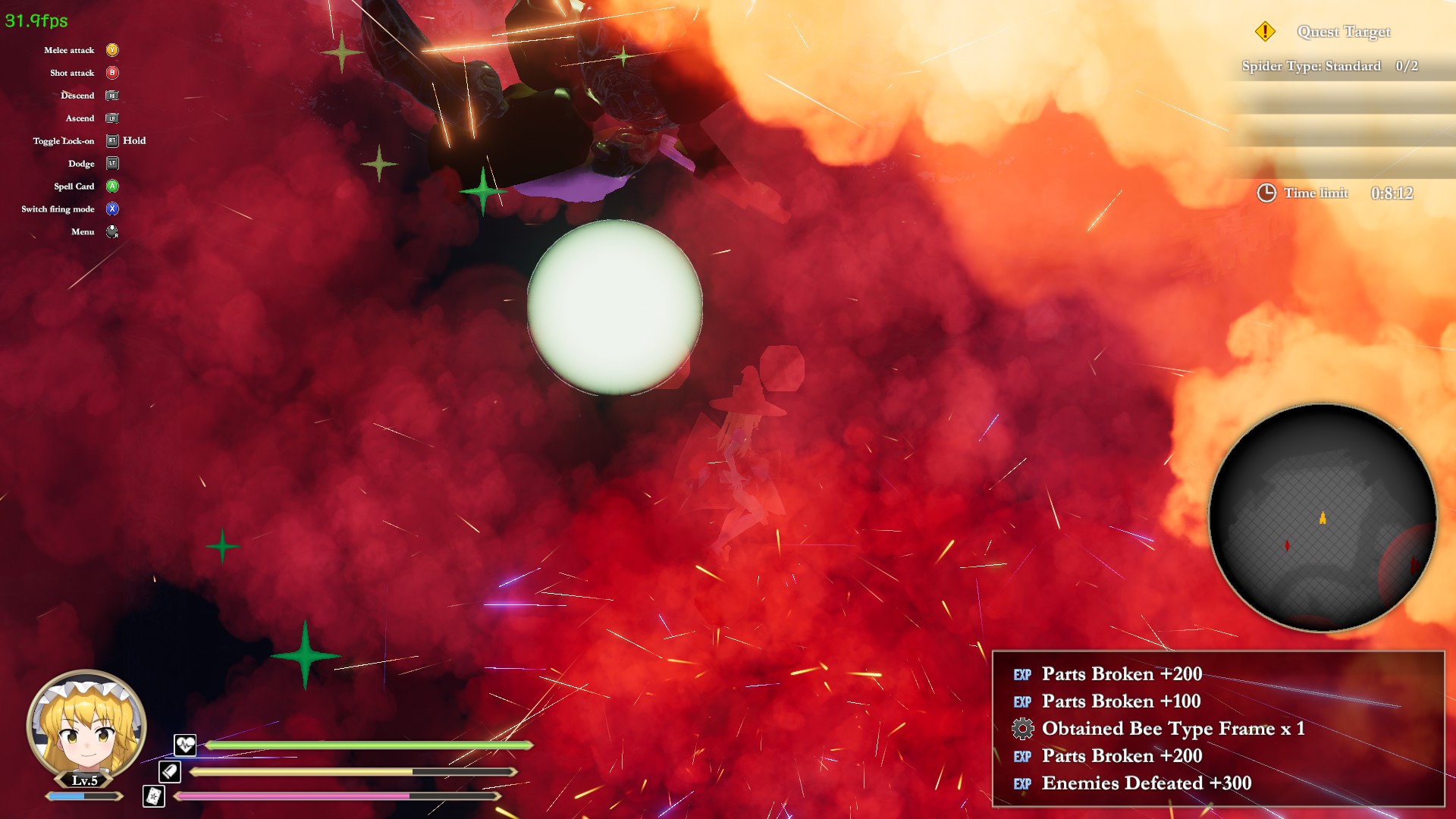
The only other thing I can add is that canonically, the Touhou characters (again, because of their anachronistic setting) are depicted as wearing bloomers or “granny panties”, partially because, as girls flying in skirts, they would easily have their underwear seen without wearing something over their undies. This game features Reimu quite clearly in what seems to be a red-and-white thong you can clearly see any time you so much as move straight forward. [sigh]
Bugs
On the one hand, there didn’t seem to be anything crashing the game or causing behavior the game obviously doesn’t intend, other than the fact that I could not open the menu mid-mission.
On the other hand, the whole way that melee is a total slip-and-slide where I can’t hit anything for my character flying uncontrollably over the target when locked on, there’s a lot of “not a bug, but a feature” elements of the game that I seriously wish would be changed.
Verdict
I don’t want to be too hard on a person who’s likely making a passion project with a very limited budget, but this is a game that is flawed in its basic concept and how they chose to implement it. The official Touhou games use things like transparent player bullets for a reason, but everything this developer did to try to overcome the inherent problems of a 3d shooter was implemented in a way that seriously needed to be reconsidered, including making it so you can’t tell your own bullets from the enemy’s. Beyond any problems with bugs or refining how characters or enemies move, there are structural gameplay concepts that are severely unsound and need to be redesigned from the ground up to make this the kind of game it aspires to be. Dump the melee. Dump the item grinding. Refocus upon dodging and aerial maneuvers.
You could possible remake this game more in the vein of Star Fox or Ace Combat and make it a much more compelling game, but the fundamental gameplay is so wrong-headed that it’s a struggle to find the fun in the game.

